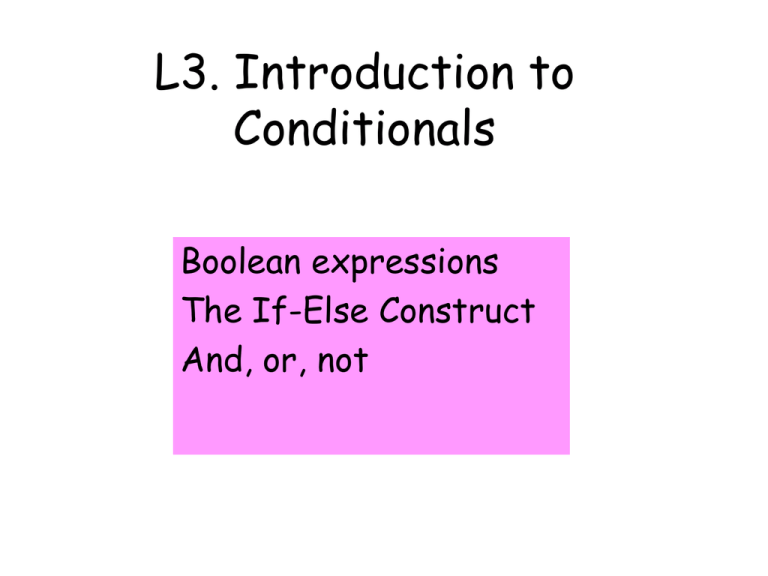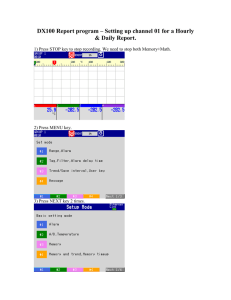L3. Introduction to Conditionals Boolean expressions The If-Else Construct
advertisement

L3. Introduction to Conditionals Boolean expressions The If-Else Construct And, or, not What We Cannot Do We cannot make a computation contingent upon other things. If the value of the arithmetic expression Dice1 + Dice2 is seven, then increase the value of the variable GamesWon by one. The If-Else Construct Solves this Problem We will introduce this language feature by solving problems about the behavior of a given quadratic q( x) x bx c 2 on a given interval L <= x <= R. Assume Variables b,c,L,R are Initialized E.g., b c L R = = = = input(‘Enter input(‘Enter input(‘Enter input(‘Enter b’:) c’:) L’:) R’:) The Situation xc b / 2 q( x) x bx c 2 L R Problem 1 Write a fragment that prints “yes” if q(x) increases across the interval and “no” if it does not. No! xc b / 2 q( x) x bx c 2 L R Yes! xc b / 2 q( x) x bx c 2 Requirement: xc <= L L R Solution Fragment xc = -b/2; if xc <= L disp(‘Yes’) else disp(‘No’) end Problem 2 Write a fragment that prints the maximum value that q(x) attains on the interval. Maximum at L xc b / 2 q( x) x bx c 2 L R Maximum at R xc b / 2 q( x) x bx c 2 Depends on whether xc is to the right or left of the interval midpoint. L R Solution Fragment xc = -b/2; Mid = (L+R)/2; if xc <= Mid maxVal = R^2 + b*R + c else maxVal = L^2 + b*L + c end Problem 3 Write a fragment that prints “yes” if xc is in the interval and “no” if xc is not in the interval. No! xc b / 2 q( x) x bx c 2 Because xc < L L R No! xc b / 2 q( x) x bx c 2 Because R < xc L R Yes! xc b / 2 q( x) x bx c 2 Because L <= xc and xc <= R L R Solution Fragment xc = -b/2; if (L <= xc) && (xc <= R) disp(‘Yes’) else disp(‘No’) end Illegal: L <= xc <= R Saying the Opposite xc is in the interval [L,R] if L <= xc and xc <= R xc is not in the interval [L,R] if xc < L or R < xc Another Solution Fragment xc = -b/2; if (xc < L) || (R < xc) disp(‘No’) else disp(‘Yes’) end Solution Fragment xc = -b/2; if (L <= xc) && (xc <= R) disp(‘Yes’) else disp(‘No’) end The if-else Construct if boolean expression Commands to execute if the expression if TRUE else Commands to execute if the expression if FALSE end Boolean Expressions (xc < L) || (R < xc) Their value is either true or false. Made up of comparisons that are either true or false. Connected by logical operators: and, or, not Boolean Expressions (xc < L) || (R < xc) Their value is either true or false. Made up of other (simpler) boolean expressions that are connected by boolean operators: and, or, not Arithmetic Expressions (x+3)*(y-z) Their value is a number. Made up of other (simpler) arithmetic expressions that are connected by arithmetic operators: +,-.*./ Relational Operators < > <= >= == ~= Less than Greater than Less than or equal to Greater than or equal to Equal to Not equal to The And Operator && && ----------------------------------------------F F F F T F T F F T T T The Or Operator || || ----------------------------------------------F F F F T T T F T T T T The not Operator ~ ~ ----------------------------------------------F T T F Question Time What is the value of X and Y after the following script is executed: X = 6; If X < Y = else X = end Y = 8; Y Y/2; X/2; A. X is 3 and Y is 4 B. X is 6 and Y is 8 C. X is 6 and Y is 4 D. X is 3 and Y is 8




